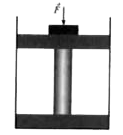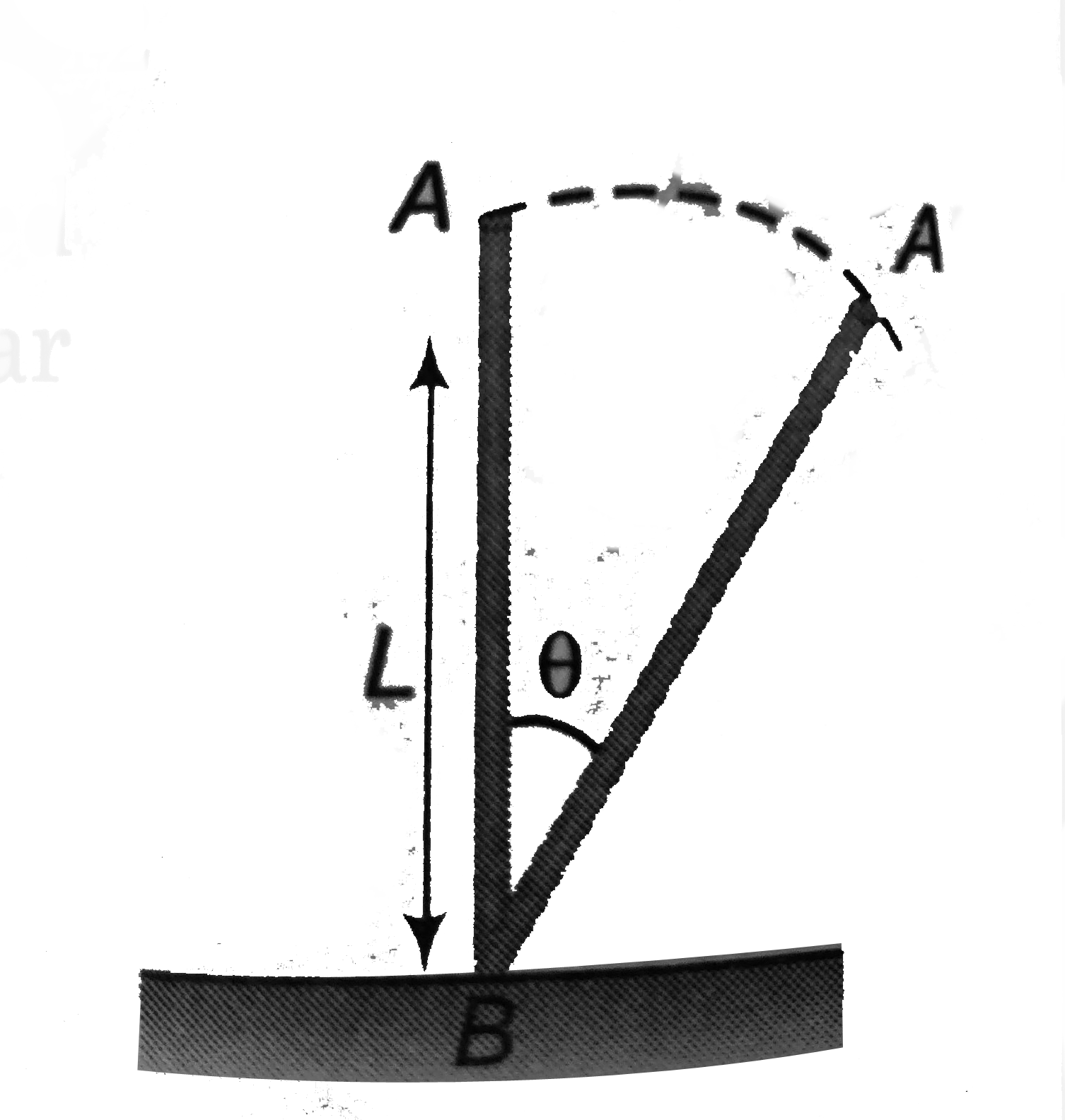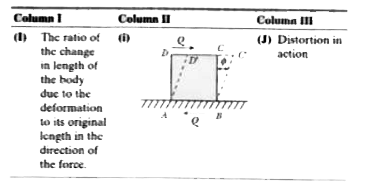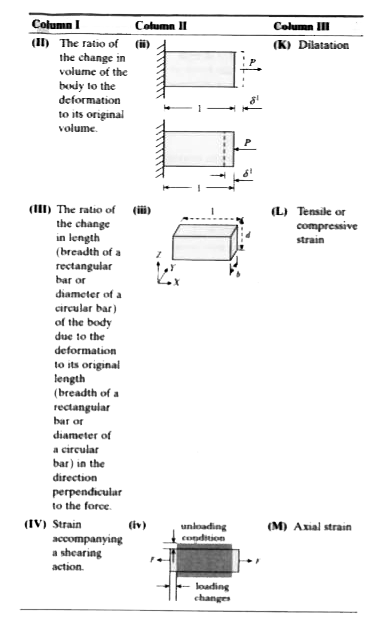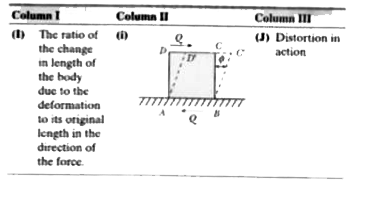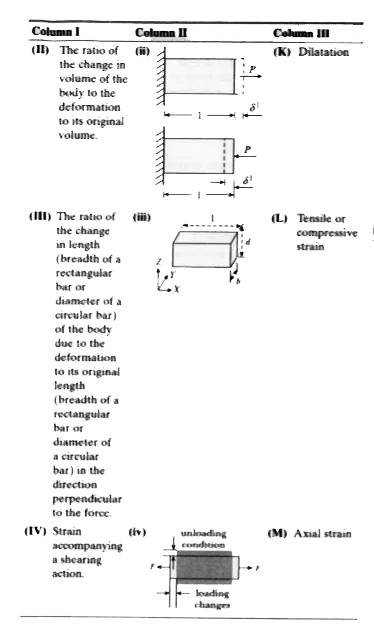PRACTICE QUESTIONS (Matrix - Match) from RESNICK AND HALLIDAY PHYSICS (HINGLISH) ELASTICITY for Class 12
| Class 12 | PHYSICS |
| Chapter | ELASTICITY |
| RESNICK AND HALLIDAY PHYSICS (HINGLISH) | PRACTICE QUESTIONS (Matrix - Match) |
| Medium | English |
| Academic Year | 2023-2024 |
Question 6
A wooden wheel of radius R is made of two semicircular part . The two parts are held together by a ring made of a metal strip of cross sectional area S and length L. L is slightly less than 2πR. To fit the ring on the wheel, it is heated so that its temperature rises by ΔTand it just steps over the wheel. As it cools down to surrounding temperature, it process the semicircle parts together. If the coefficient of linear expansion of the metal is α, and it Young's modulus is Y, the force that one part of the wheel applies on the other part is :
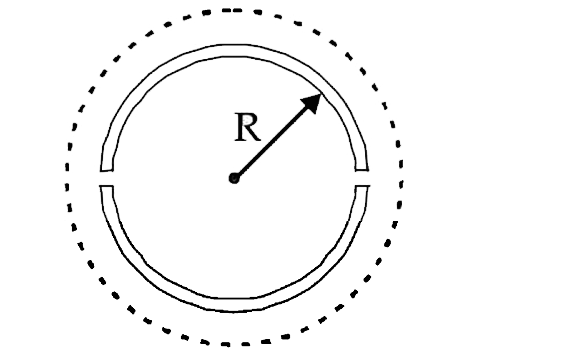 View Solution
View SolutionQuestion 11
A uniform rod of mass m. length L, area of cross- secticn A is rotated about an axis passing through one of its ends and perpendicular to its length with constant angular velocity o in a horizontal plane If Y is the Young's modulus of the material of rod, the increase in its length due to rotation of rod isView SolutionQuestion 12
Between each pair of vertebrae in the spinal column is a cylindrical disc of cartilage. Typically, this disc has a radius of about 3.0×10−2m and a thickness of about 7.0×10−3m. The shear modulus of cartilage is 1.2×107N/m2. Suppose a shearing force of magnitude 11 N is applied parallel to the top surface of the disc while the bottom surface remains fixed in place. How far does the top surface move relative to the bottom surface ? View SolutionQuestion 13
The figure shows two creates that are connected by a steel wire that passes over a pulley. The unstretched length of the wire is 1.5 m, and its cross - sectional area is 1.3×10−5m2. The pulley is frictionless and massless. When the crates are accelerating, determine the change in length of the wire. Ignore the mass of the wire.
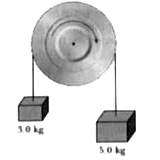 View Solution
View SolutionQuestion 15
A spring with constant k = 78 N/m is at the base of a frictionless, 30.0∘ inclined plane. A 0.50 kg block is pressed against the spring, compressing it 0.20 m from its equilibrium position. The block is then released. If the block is not attached to the spring, how far up the incline will it travel before it stops ?
 View Solution
View SolutionQuestion 16
The maximum compressional stress that a bone can withstand is 1.6×108N/m2 before it breaks. A thighbone (femur), which is the largest and longest bone in the human body, has a cross - sectional area of 7.7×10−4m2. What is the maximum compressional force that can be applied to the thighbone ? View SolutionQuestion 17
The shear modulus of steel is 8.1×1010N/m2. A steel nail of radius 7.5×10−4m projects 0.040 m horizontally outward from a wall. A man hangs a wet raincoat of weight 28.5 N from the end of the nail.Assuming the wall holds its end of the nail, what is the vertical deflection of the other end of the nail ? View SolutionQuestion 18
A gymnast does a one - arm handstand. The humerus, which is the upper arm bone between the elbow and the shoulder joint, may be approximated as a 0.30 - m - long cylinder with an outer radius of 1.0×10−2m and a hollow inner core with a radius of 4.0×10−3m. Excluding the arm, the mass of the gymnast is 63 kg. What is the compressional strain of the humerus ? View SolutionQuestion 19
A solid brass sphere is subjected to a pressure of 1.0×105 Pa due to the Earth's atmosphere. On Venus the pressure due to the atmosphere is 9.0×106 Pa. By what fraction Δr/r0 (including the algebraic sign) does the radius of the sphere change when it is exposed to the atmosphere on Venus ? Assume that the change in radius is very small relative to the initial radius. View SolutionQuestion 20
A cylindrically shaped piece of collagen (a substance found in the body in connective tissue) is being stretched by a force that increases from 0 to 3.0×10−2N. The length and radius of the collagen are, respectively, 2.5 and 0.091 cm, and Young's modulus is 3.1×106N/m2. If the strtching obeys Hooke's law, what is the spring constant k for collagen ? View SolutionQuestion 21
One end of a piano wire is wrapped around a cylindrical tuing peg and the other end is fixed in place. The tuning peg is turned so as to stretch the wire. The piano wire is made from steel (Y=2.0×1011N/m2). It has a radius of 0.80 mm, and an unstrained length of 0.76 m. The radius of the tuning peg is 1.8 mm. Initially, there is not tension in the wire. Find the tension in the wire when the tuning peg its turned through two revolutions. View SolutionQuestion 33
Using Searle's apparatus while determining the Young's modulus of a wire, a girl is taking measurements of different parameters : Length of the wire, L, is 30 cm, which is measured with a millimeter scale , diameter of the wire, d, is 1 mm, which is measured with a screw gauge. (Least count of the screw gause is 0.01 mm, least count of the spherometer attached to the apparatus frame is 0.005 mm, spherometer attached to the apparatus frame is 0.005 mm , spherometer measured the extension e of the wire , W is the weight of the loads.)
The parameter that should be measured more carefully is View SolutionQuestion 34
Using Searle's apparatus while determining the Young's modulus of a wire, a girl is taking measurements of different parameters : Length of the wire, L, is 30 cm, which is measured with a millimeter scale , diameter of the wire, d, is 1 mm, which is measured with a screw gauge. (Least count of the screw gause is 0.01 mm, least count of the spherometer attached to the apparatus frame is 0.005 mm, spherometer attached to the apparatus frame is 0.005 mm , spherometer measured the extension e of the wire , W is the weight of the loads.)
The load versus extension graph should be (if the extension is in elastic limit)View SolutionQuestion 35
Using Searle's apparatus while determining the Young's modulus of a wire, a girl is taking measurements of different parameters : Length of the wire, L, is 30 cm, which is measured with a millimeter scale , diameter of the wire, d, is 1 mm, which is measured with a screw gauge. (Least count of the screw gause is 0.01 mm, least count of the spherometer attached to the apparatus frame is 0.005 mm, spherometer attached to the apparatus frame is 0.005 mm , spherometer measured the extension e of the wire , W is the weight of the loads.)
The maximum fractional error in the measurement of Y is View SolutionQuestion 36
Match the statement in Column I with the statements in Column II. One or more than one choice from Column II can match with a statement from Column I.
Column IColumn II(a)If the wire is pulled at its ends(p)Young'sby equal and opposite forces ofmodulus (Y)magnitude F so that it undergoes anelongation x, according to Hooke'slaw, F=-kx, where k is the forceconstant, Force constant (k) of thewire will depend on(b)Let us suspend the wire vertically(q)elongation (x)from a rigid support and attacha mass m at its lower end. If themass is slightly pulled down andreleased, it executes SHM of a timeperiod that will depend on(c)If the given wire is fixed between(r)length (l)two rigid supports and itstemperature is decreased, then thethermal stress that develops in thewire will depend on(d)Work done in stretching the wire(s)area of cross-to a length l + x will depend onsection (a)View SolutionQuestion 41
The Leaning Tower of Pisa is 59.1 m high and 7.44 m in diameter. The top of the tower is displaced 4.01 m from the vertical. Treat the tower as a uniform, circulary cylinder. What additional displacement (in m), measured at the top, would bring the tower to the verge of toppling ? View SolutionQuestion 42
A cylindrical aluminium rod, with an initial length of 0.8000 m and radius 1000.0 μm, is clamped in place at one end and then stretched by a machine pulling parallel to its length at its other end. Assuming that the rod's density (mass per unit volume) does not change, find the force magnitude that is required of the machine to decrease the radius to 999.9μm (The yield strength is not exceeded, Ealuminium=70×109N/m2).View SolutionQuestion 43
Figure shows a 300 kg cylinder that is horizontal. Three steel wires support the cylinder from a ceiling. Wires 1 and 3 are attached at the ends of the cylinder, and wire 2 is attached at the center. The wires each have a cross - sectional area of 2.00×10−6m2. Initially (before the cylinder was put in place), wires 1 and 3 were 2.0000 m long and wire 2 was 6.00 mm longer than that. Now (with the cylinder in place), all three wires have been stretched. What is the tension in wire 1 (kN) ? (Esteel=200×109N/m2)
 View Solution
View Solution

